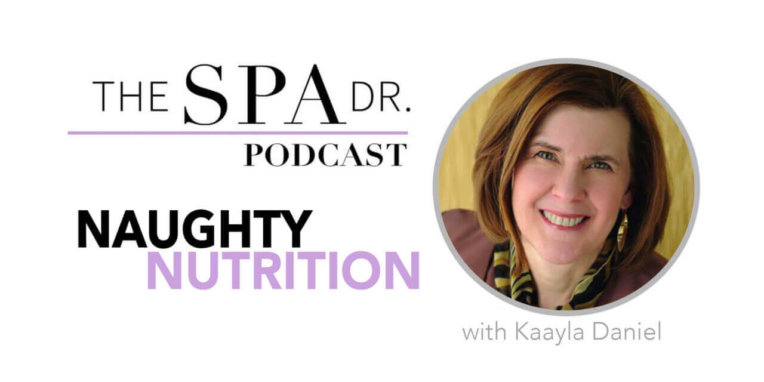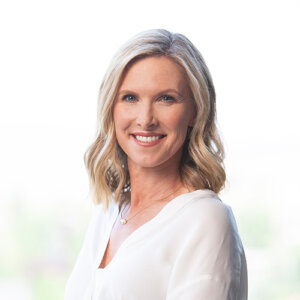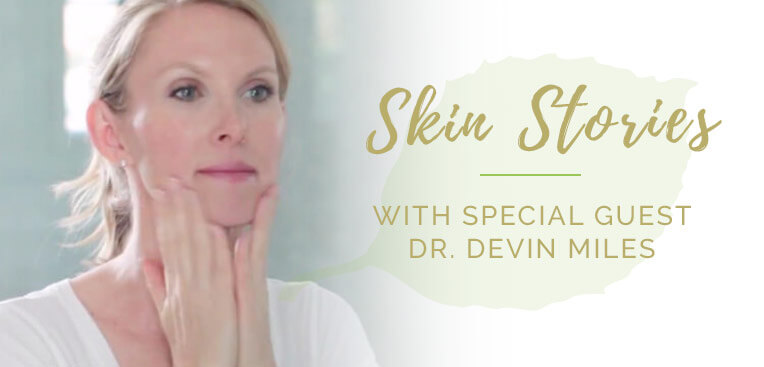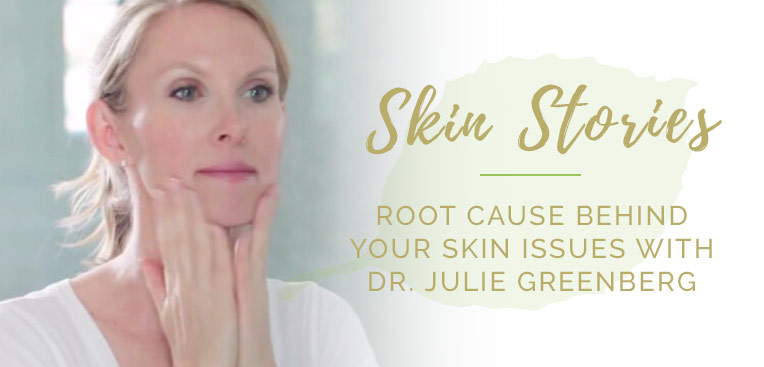Today we’re talking about some specific foods that are good or bad for skin that have been somewhat controversial or new to the market.
My guest is Kaayla T. Daniel, PhD who is known as the Naughty Nutritionist®. She is an author, speaker and has appeared on Dr. Oz, PBS Healing Quest & other shows, and been a speaker at Paleo f(x), Ancestral Health and other conferences. She received the Integrity in Science Award from the Weston A. Price Foundation in 2005, the Health Freedom Fighter Award from Freedom Law School in 2009, and the BadAss Award from the Paleo-Primal-Price (Hunt Gather Grow) Foundation in 2015.
In today’s interview, I talk with Kaayla Daniel about foods for the skin with a focus on bone broth, soy, dairy products and camel’s milk, with specific tips on each of these.
So please enjoy this interview…
To learn more about Kaayla, you can visit her website here.
TRANSCRIPTION:
Trevor: Hi there, I’m Dr. Trevor Cates. Welcome to The Spa Dr. Podcast. Today we’re talking about some specific foods that are good or bad for your skin. And some of these have actually been somewhat controversial, and some are new to the market. My guest is Dr. Kaayla Daniel and she is known as the Naughty Nutritionist. She is an author, speaker, researcher and has appeared on Dr. Oz, PBS and other shows that you may have seen. She’s also received some awards; The Integrity in Science Award, from Weston A. Price Foundation, the Freedom Fighter Award and the Bad-Ass Award from the Paleo-Primal-Price Foundation. And today’s interview is talking about the foods for the skin that are particularly good, and some that are actually not good. So, we’re gonna be talking about foods like, bone broth, soy, dairy products and camel’s milk. Can you guess which ones are maybe the good ones? Which ones maybe aren’t so good? But we’re gonna be talking about specific tips on each of those good ones, so you know how to get them in your diet. So please enjoy this interview.
Trevor: Kaayla, it’s so great to have you on my podcast. Thanks for joining us.
Kaayla: Thank you!
Trevor: Alright, so I know you’re known as the Naughty Nutritionist. Love that name. And you were on my Glowing Skin Summit, I interviewed you a while back. And so let’s talk about some of the foods that are good for our skin. Things that people should be getting in their diet, and then some of the things that maybe are considered health foods but aren’t particularly good for our skin. So what do you think are some of those tops ones? And I know I’ve got my ideas, and I think we’ve got some overlapping opinions on this, so we’ll see.
Kaayla: Well my number one Superfood, and of course I have to bring a little mischief in here, but the Superfood is bone broth. And can’t emphasize that enough. And now that it’s winter, it’s the perfect time for soups, for stews, for gravy, for all the ways we can incorporate bone broth into our diet and yes, I do love the real thing, just like grandma used to make.
Trevor: Good, yes. It’s definitely a great one because of all the great collagen in bone broth. So let’s talk about how to make it, because sometimes it’s a daunting thing for people, maybe they’re just thinking, “Oh I need to go pick that up at the store.” But it’s actually really easy to make, and I think the nutritional content of a home-made bone broth is … I just don’t know that you can match that.
Kaayla: Well, I call it a fast food because the time it takes to make it is actually very little. But it is going to cook for hours and hours, but it’s not like we have a stockpot on the stove. We can put it in a Crock-Pot or Insta-pot, or any of those things. We can go to work in the morning, come home, and guess what? It’s all done. Or go to sleep at night and in the morning it’s all done. So it really is a fast food. But as with a lot of real food cooking it’s a habit. So the first time you do it, it might seem a little daunting, but basically just throw in a bunch of bones and good joint bones, and plenty of them, and onions and celery, a little apple cider vinegar, use good quality water, and you really can’t go wrong. Now, when people do find their bone broth doesn’t taste too good, the general reason they’ve got no flavor, is maybe they add too little bones in a gallon of water. So you really do need a substantial of the bones to fill your pot up and cover it with the water.
Kaayla: And if there’s meat on those bones you’re going to get some very rich flavor in there. So I often talk about how, yes you can make bone broth with wilted celery and dead onions and the carcass with no meat on it, but it’s going to be kind of weak. So the more quality you have with your ingredients, the fresher, the better, the more flavorful.
Trevor: Okay, great. And how much apple cider vinegar should people use, do you think?
Kaayla: You can just splash it in. It’s gonna depend on how much you’re making. I’m usually throwing in a tablespoon or two. If you’re using a really big stockpot, more than that. And some people like to cook enough for a month, and then do freezing. I tend to have a Crock-Pot going most of the time. So small batches, but I keep it going.
Trevor: Yeah. And the apple cider vinegar is to help pull the nutrients out of the bones and vegetables, right?
Kaayla: Yes. And I think it helps with that, but you’ll also notice that you’ll get some of the gelatin even if you forget the apple cider vinegar, or if you roast a chicken there’ll be gelatin underneath it. So, if you roasted the chicken and then you eat it and then you’re gonna use the bones to make broth, some of that gelatin you’ve already achieved. So, in that case you might want to add some gelatin powder later to make it jiggly.
Trevor: And so some people will say to scoop off the stuff on the top after you make bone broth. What do you think? Do you skim anything off the top, or do you leave it all in there?
Kaayla: Well, some of that stuff on the top will be the fat. And gourmet cooks will take that off because of flavor. Flavor issues and appearance issues. So it’s not that the fat’s evil, but if you’re a gourmet chef your broth’s gonna taste better if you take it off. And ideally we’re all gonna be using, say if we’re making chicken broth, it’s gonna be chickens that are free-range and running around and cavorting with roosters and so-forth, but when people end up having to use, for whatever reason, say a supermarket chicken, you’re gonna get a whole lot more scuz at the top from the toxicity. So, especially important for those people to be skimming off. And you’ll just notice a difference with the quality of your chickens in terms of how much there is to take off, in terms of, what I would loosely call the skuz that rises to the top as you’re cooking it.
Trevor: And then also some people say that you should cook the bones first before you put ’em in the water. Now what do you think, as far as roasting large bones, the bone marrow first before putting ’em in the water? Or just putting ’em in raw? What do you think?
Kaayla: Well I do both. Now I typically will roast, say, the oxtails of the bone marrow bones. And of course if you’re doing the marrow bones you may wanna be scooping it out, I mean that’s an absolute primal, gusty delight if you wanna do that. But one of the ways we get marrow into our diet is just through soup, because there even is a little marrow say, in chicken bones, poultry bones. Not very much, you’re not gonna have anything you can scoop out, but one of the ways to get it in your diet is through the broth. So, that’s an option. Now, I mentioned before that if you roast a chicken that you can make the broth with the roasted carcass, and that will give you a broth that has a different flavor than say, if you take chicken feet and just … Now the chicken feet are a very inexpensive way to get a very rich and golden, wonderful, simple broth. Chicken you’re going to get all the flavors of whatever you used when you roasted the chicken, say if it’s lemon and thyme or it’s some sort of barbecue or whatever, you’re gonna have barbecue broth.
Kaayla: Those flavors can all be delicious. You can’t really go wrong. But it’s gonna be a variation. But in terms of making, say, the beef broth, or oxtail soup or stew, the roasting will enrich the flavor substantially.
Trevor: Yeah, I’ve noticed that as well so I wanted to point that out. But as far as the nutritional content, it’s gonna be the same, right? It’s just the flavor of it, correct?
Kaayla: Yeah, people have said, “Well, if I’m roasting the chicken, I’m gonna lose some nutrition in the broth.” Well, yes, but you also ate the chicken, so you’re getting it regardless, right?
Trevor: Yeah. It’s all gonna get in your body eventually. I love this idea of not wasting, too. You make a chicken and why throw it out? Same thing with turkey on Thanksgiving. It’s one of my favorite things about Thanksgiving, is after where it’s making the bone broth from the turkey carcass and the leftover turkey that’s there.
Kaayla: Well we can get a lot of good nutrition that way. And many people who are new to real foods, and organic, and pasture-raised, grass-fed et cetera are very concerned about the cost. Especially if it’s a big family, the greater cost. But if we’re using all parts of the animal, if we’re doing nose to tail eating, it’s not so bad. People often are leaning towards the steaks and chops, but if we also include the organ meats and the cheaper cuts, and of course use the carcass for the bone broth it becomes a lot more economical.
Trevor: Okay. And what about fish bones? Do you often make broth with fish bones?
Kaayla: I don’t do that as often, but I live in Albuquerque, so there’s not a whole lot of fresh, good seafood local. But I will, and that can be delicious. But more often, my seafood chowders will be with say, frozen seafood and maybe I’ll have the chicken broth that I’ve made myself as the base.
Trevor: Right. But it is an option for people who maybe they’re pescatarian. They’re choosing to eat fish as their source of animal protein. That is an option, correct?
Kaayla: Absolutely, and with the fish you’re going to get some of the thyroid hormones, you’re gonna get some of the brain hormones, many things you’re gonna get from the fish carcass that you’re probably not going to get from say, chicken bones, or beef bones or venison.
Trevor: Interesting. And then I guess we’ve got some other options for great foods for skin health. What are some of your other favorite ones?
Kaayla: Well, in general: quality ingredients, organic pastured. The less toxicity, the better. Because I think that’s A-1 for beautiful skin, is the less toxicity we put in, the better our skin’s going to look. So it’s an inside-out proposition. Gotta pay attention to the outside-in part as well, with quality, organic skin-care products too. But a lot of people are really busy with the outside, and we wanna think inside too. So, yes organic, plenty of vegetables. So, if you’re on paleo diet, quality meats plus plenty of vegetables. With the ketogenic diet, you still have those vegetables, quality meats and fats. Plenty of fats. For so long people were on the low-fat diets and your skin wants good fats for nourishment. So, whether we’re talking Ayurvedic medicine, or Chinese medicine, or just our own common sense, including plenty of the genuine fats mother nature gave us.
Trevor: Great. Absolutely. Yeah, I agree with that. And how do you feel about soy products?
Kaayla: Well, I did a hope book on the dangers of soy foods, and we have more than seventy years of studies linking soy to malnutrition, thyroid problems, immune problems, on and on. Even contributing to causing and accelerating the growth of cancer, even causing some forms of heart disease, so soy really is not a health food. Now, I don’t have studies about soy and skin, but if soy is damaging the thyroid, which often happens, a very common side effect from excessive soy consumption, the skin’s going to be affected. Think dryness, for example, low thyroid and how dry people get from that. Low energy, dryness, constipation, all of that’s gonna show up in the skin.
Trevor: Okay, great. And how about dairy products?
Kaayla: Dairy products. Very interesting question. There are people who say never eat dairy, that dairy is only designed for a nursing calf, et cetera, that we should have no dairy. And then there’s people who feel they really thrive. They talk about peaches and cream complexions. So for some people dairy, if it’s fresh, raw dairy from healthy cows, and if they tolerate dairy well, can be a health food for those people. Other people don’t do well on any dairy products, and something I’ve been researching the last year or so: camel’s milk. And camel’s milk, not everybody finds camel’s milk locally. But I think that’s going to be a growing trend because it’s absolutely delicious. And there’s research coming in supporting that it can be tolerated by many people who can’t tolerate any other kind of dairy. People who can’t tolerate cow’s milk, even the A2 cow’s milk that some people can tolerate. Raw cow’s milk, even sheep’s milk or goat’s milk. Some of those people just thrive on camel’s milk.
Kaayla: And it can heal so many diseases, with the gut healing the immune healing, so it’s not only giving nourishment to many people who are having trouble tolerating any foods, but that camel’s milk can actually heal some of the problems. So, that’s the really exciting research. And the way I would put it is, camels have evolved to thrive in some of the harshest conditions ever on the planet. The deserts. And they survive and they thrive. So what could be more perfect for people trying to survive in our really toxic, difficult, modern world?
Trevor: Yes, interesting. And so I know that dairy products definitely, I’ve certainly found with my experience too, to be one of the biggest trigger foods for skin issues. And it’s not true for everyone, like you said. But it does seem to be one of the top trigger foods for a lot of people, especially those with chronic skin issues, and other health issues too. And so I know I have had people that don’t do well on cow’s milk products, sometimes they do okay on goat’s or sheep’s milk products like the yogurt, or cheeses, and they’ve tolerated those a little bit better. But then again some people can’t do any of that.
Trevor: So this idea of a camel’s milk is kind of a new thing that’s just come to our attention. That’s become more available to us here in the U.S. and so I don’t actually have any personal experience with the camel’s milk, but I’ve been interested in it because I’ve heard about it. In going to some of the conferences I’ve seen camel’s milk products out there. I know someone that’s working on a camel’s milk formula for infants, and some interesting things that are coming out with camel’s milk. So, I’m curious to learn more about it and see how this unfolds.
Trevor: Any other things that you can explain about the camel’s milk and how it’s different, and why some people tend to be tolerating it more? One of the things that comes to my mind is, it’s new to us. A lot of times we just, with dairy products, with cow’s milk in particular, it’s been in so many of our food products, that we’ve just become sensitive to it because we’ve been exposed to it so much. And that many of us were exposed to cow’s milk maybe too early in our life, when we were infants, so it created gut issues early on. But perhaps camel’s milk is, I don’t know what could be different about it, but it sounds like maybe it is.
Kaayla: Well, I think you’re making a very good point that just about all of us were from a very early age, exposed to pasteurized, commercial cow’s milk, and if you become super sensitive to that, even the better forms, such as the raw cow’s milk, may be something you’re still reactive to. Hopefully not, but it can very well happen. So the camel’s milk is different enough so the body’s not reacting. And having some of the healing capacity of say, breast milk, and we were evolved to thrive on breast milk, but our world is so toxic now that even some babies are not tolerating their own mama’s breast milk. And that’s just very, very sad.
Trevor: Yeah, so it seems to be helping people with allergies as well? Camel’s milk, from what you’ve been reading about it?
Kaayla: Yes, very much, so. We’ve got around a hundred and fifty research studies at this point. Many done with Arabian researchers. But many of them are very good studies. Not all of them, of course, but we’ve got enough good studies so that the evidence really is coming in. Now, in terms of the people with allergies, what gets very interesting is how the first thing is, if they can actually tolerate the camel’s milk. They’re going to get some real nutrition in their diet because many of these children are the ones who are reacting to everything and their diets become more and more limited. And it’s a nightmare for the parents, they’ve got children who are failing to thrive, but children who are reacting to everything. And even if those children can say, tolerate something like rice milk, there’s really no nutrition in there. It’s a substitute that maybe they don’t react to, but it’s empty calories. And we need something to help those little bodies and brains grow.
Trevor: Yeah, and soy was oftentimes used as an alternative too for people. And I think we’re getting more away from the soy. As you mentioned before, there are some issues around soy, so people are looking for alternatives for nutrients for our little ones.
Kaayla: Absolutely. And camel’s milk is not cheap of course, but when your child can thrive on it where nothing else seemed to work, and even start to heal, just amazing. And many of those allergic children, they’re facing a lot of very difficult skin problems, all the eczema’s. And the older folks, the psoriasis, so things we’re not reacting to, it’s life changing for people who suddenly see their skin clear up, where it was painful, it was ugly, they didn’t wanna go out in public. So many blessings.
Trevor: Yes, and so what else is the research showing? You mentioned to me that you’ve seen some things around auto-immune diseases as well. And some research on that. What have you found on those?
Kaayla: Well, most of the research is on autism, and we have most of the testimonials from the parents of autistic children, who have started to really heal and thrive after taking on camel’s milk. So some of the reasons for it have to do with healing the gut, it always starts with the gut, and camel’s milk including unique immunoglobulins, the secretory, IGA, helping heal the gut. Camel’s milk also [inaudible 00:20:31] containing unique oligosaccharides. Now what we often think of oligosaccharides being, what causes flatulence. Beans, beans the musical fruit. So that’s what we think of, and I could predict people would say, “Well, even if it makes my skin better, I don’t wanna have a lot of gas problems.” But it’s different oligosaccharides, they’re healing oligosaccharides that are very involved in the immune system and the gut. So we know most of our immune system is in the gut, and there you go. Heal the gut, heal the brain, heal the immune system,
Trevor: Interesting. And is the difference because of the diet that camels have? I don’t know much about camels because we don’t have any walking around Utah!
Kaayla: Not too many in New Mexico, but they could thrive in Utah. There are some herds in Colorado. They would thrive in New Mexico. There’s herds in Texas. They actually thrive in many different climates and not just Arabia or Australia, which is where people think of them being. So, their diet would be wild. They are foraging, they’re not fed very much, so it’s mother nature’s diet that those camels are on. And some of the other issues is camel’s milk is naturally the form of A2 protein that people are less likely to react to. Now, some types of cows, like the little Jersey cows, the long-horned cows, some of the Indian cows, are A2 as well. Sheep are A2, goats are A2, reindeer are A2. Bet reindeer milk would be great for our skin and health too.
Trevor: Okay, alright. Reindeer milk, that’s kind of a new one to me, but that’s right around the corner as well.
Kaayla: Well if Santa was drinking the reindeer milk, and less of all those cookies and carbs, Santa would be very, very slim and handsome!
Trevor: Probably so! Okay, so with cow milk, can people find out that they get that particular milk from those particular cows? How do you know? That’s an interesting concept too, that maybe down the line we’re not gonna just have cow’s milk, but from specific types of cows that have healthier milk. I hadn’t even thought about that, but that’s an interesting concept.
Kaayla: Well, you can ask your farmer if they have A2 cows, and more and more of the small farmers are switching their herd over from A1 and perhaps A1 and A2 cows, over into a pure A2 herd. And there’s many reasons that’s beneficial, they can actually make more money that way because they can sell the pure A2 milk for more money.
Trevor: And why exactly is A2 better? Can you explain that a little bit more?
Kaayla: Yeah, it’s an A2 form of protein that is much better tolerated that’s not triggering all sorts of reactions to the casein. So the children with autism and many of the people who are reacting to cow’s milk, it’s often not a lactose or milk sugar issue, it’s a milk protein, a casein issue. So, having the A2 form of casein people are much less likely to start reacting negatively to that.
Trevor: Interesting. Well, these are all really great things to be aware of. And where do people find camel’s milk right now? How do people get it? And you said it is more expensive too.
Kaayla: It’s definitely more expensive, and most people will get it online. And I do recommend Desert Farms. And if you’re really lucky, there may be some camel farmers in your own backyard, or in your neighborhood.
Trevor: That’s great. And what is the general cost? Do you know the cost of camel’s milk?
Kaayla: It’s like eighteen dollars a pint.
Trevor: Oh wow. Yeah.
Kaayla: So it adds up fast. But if it can heal somebody who’s really challenged, it’s a miracle at any price.
Trevor: So this isn’t something that people would be putting on their cereals or in their coffee, but it’s something that they’re actually drinking for nutritional benefit? So it’s a different way of looking at a dairy product?
Kaayla: Yeah, I’ve used it in my coffee. I tend to be a low-carb person, but if I were eating cereal the milk I’d put on it: camel’s milk. And it is delicious. It’s very white, I think people are afraid it’s going to taste camel-y. People think goat milk is too goat-y, they say. So people have been intimidated
Trevor: Right. Yes. This is inspiring me to try it, I haven’t tried it. Like I said, I’ve seen it at conferences, and hear people talking about shifting to doing more camel’s milk, so I’m interested to see more of this come out and try it myself. Well, thanks for sharing that information with us! Kaayla, tell everybody how they can learn more about you, and what you’re up to.
Kaayla: Well, I’m the Naughty Nutritionist, telling the truth that’s too hot to handle. So I take on a lot of controversies because people are overwhelmed with all the information out there, how inconsistent and contradictory it can be, and I have a little fun with it and try to provide good education plus entertainment at the same time. Website is Drkaayladaniel.com.
Trevor: Great. Thank you. And I think it is interesting, when it comes to food there are definitely a lot of different opinions out there. A lot of different … Sometimes it’s just people opinions and it’s not based upon any research. So I appreciate you taking time to look at research, and correlating that with the foods and the information that you’re sharing, rather than just maybe and idea or a philosophy that somebody might have. Looking at science behind it is always a good way to think about our foods and what we choose to eat, and our diets.
Kaayla: Yes, I think the combination of good science plus mother nature’s wisdom. That’s very powerful.
Trevor: Absolutely. Yes, certainly there are certain things that mother nature can help us with for sure. And knowing things that are in their whole form, and that we’re getting back to nature, can’t really go too wrong with that. It’s a great place to start, anyway. Thank you so much again for your interview. I appreciate you coming on.
Kaayla: Thank you!
Trevor: I hope you enjoyed this interview today with Kaayla. We got some tips on maybe some foods to start enjoying to include in your diet, such as bone broth, and maybe even camel’s milk if you’re ready for that. And to learn more about Kaayla, you can go to my website, thespadoctor.com. Go to the podcast page with her interview and you’ll find all the information and links there. And while you’re there, I invite you to join The Spa Dr. community, or you can subscribe to the podcast on iTunes, so you don’t miss any of our upcoming shows. And if you haven’t done so already, I highly recommend you get your own customized skin report at theskinquiz.com. It’s free, takes just a few minutes, you’ll find out what information your skin is trying to tell you about your health, and what root causes might be holding you back from the skin you want and deserve. So just go to theskinquiz.com and get your own customized skin report. Also, I invite you to join me on social media, on Facebook, Twitter, Instagram, YouTube and join the conversation. And I’ll see you next time on The Spa Dr. Podcast.








Reader Interactions